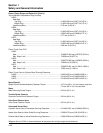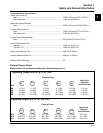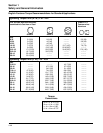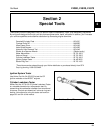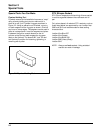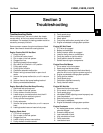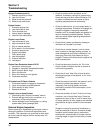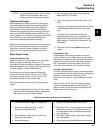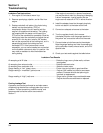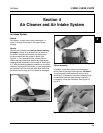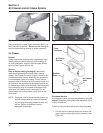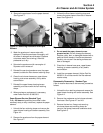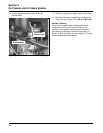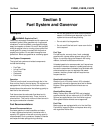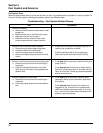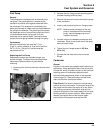
3.4
Section 3
Troubleshooting
Leakdown Test Instructions
1. Run engine 3-5 minutes to warm it up.
2. Remove spark plugs, dipstick, and air filter from
engine.
3. Rotate crankshaft until piston (of cylinder being
tested) is at top dead center (TDC) of
compression stroke. You will need to hold the
engine in this position while testing. The holding
tool supplied with the tester can be used if the
PTO end of the crankshaft is accessible. Slide the
holding tool onto the crankshaft and adjust the set
screw to fit in the key slot. Install a 3/8" breaker
bar into the square hole of the holding tool, so it is
perpendicular to both the holding tool and
crankshaft PTO. If the flywheel end is more
accessible, you can use a breaker bar and socket
on the flywheel nut/screw to hold it in position. You
may need an assistant to hold the breaker bar
during testing.
If the engine is mounted in a piece of equipment,
you may be able to hold it by clamping or wedging
a driven component. Just be certain that the
engine cannot rotate off of TDC in either direction.
4. Install the adapter hose into the spark plug hole,
but do not attach it to the tester at this time.
5. Connect an adequate air source to the tester.
6. Turn the regulator knob in the increase
(clockwise) direction until the gauge needle is in
the yellow “set” area at the low end of the scale.
7. Connect tester quick-disconnect to the adapter.
Note the gauge reading and listen for escaping air
at the carburetor intake, exhaust outlet, and oil fill/
dipstick tube.
8. Check your test results against the table below:
Cooling Leakage Test
A pressure test can be performed as a simple means
of determining whether the cooling system may have a
problem. The test procedure, possible results, and
recommended corrective action are covered in
Section 7.
Leakdown Test Results
Air escaping at oil fill tube .............................................................Defective rings, worn cylinder walls, or blown
head gasket.
Air escaping from exhaust outlet ..................................................Defective exhaust valve.
Air escaping from carburetor inlet .................................................Defective intake valve.
Gauge reading in ‘‘low’’ (green) zone ............................................Piston rings and cylinder in good condition.
Gauge reading in ‘‘moderate’’ (yellow) zone.................................. Engine is still usable, but there is some wear
present. Customer should start planning for
overhaul or replacement.
Gauge reading in ‘‘high’’ (red) zone .............................................. Rings and/or cylinder have considerable wear.
Engine should be reconditioned or replaced.



